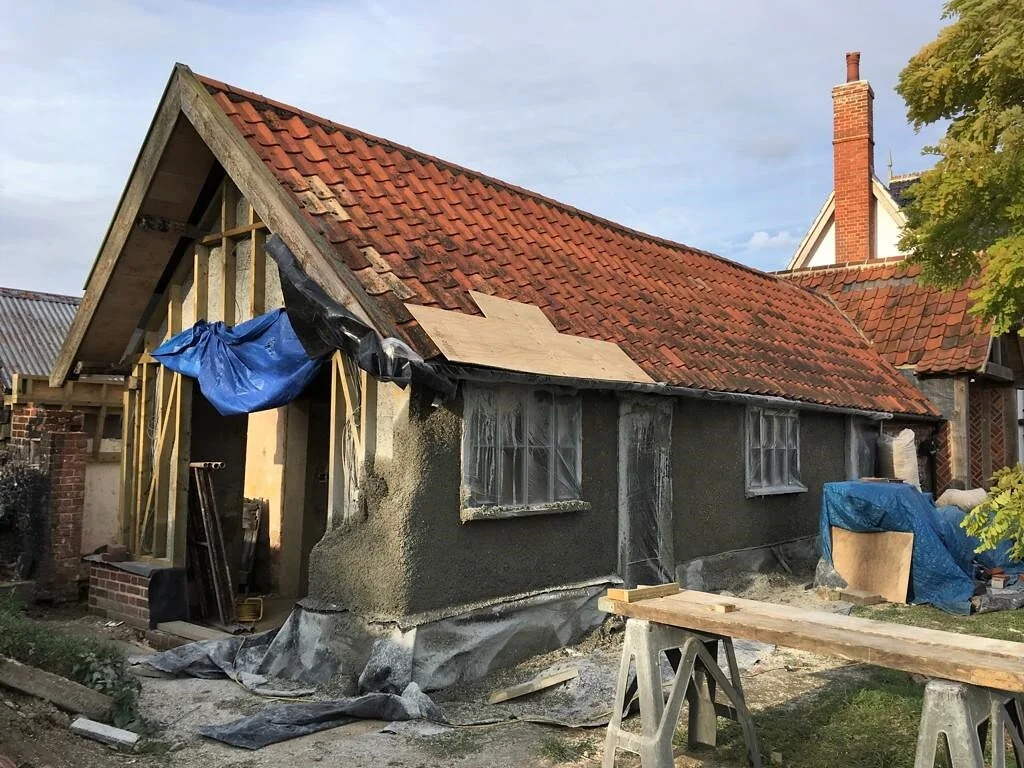Hempcrete for Historic Renovations Cont.
The inner daub and internal plasterwork on this wattle and daub wall were able to be preserved because it was sprayed with hempcrete. Photo courtesy of Graham Durrant
Continued from Home page…
Spraying hempcrete also provides much better adhesion to the substrate than hand-casting and this can be particularly useful in renovation. Where a stone or masonry building is being renovated the thickness of the hempcrete is a crucial factor as to whether the hempcrete is relying on adhesion to the substrate or is a self-supporting hempcrete wall. For example, if a 60mm coating of hempcrete is applied to an existing wall the hempcrete layer will rely largely on adhesion to the wall for its strength.
If the hempcrete is more than 120mm thick the adhesion to the wall becomes less important as the hempcrete would then be a solid enough wall in its own right. Theoretically, if the original wall were removed the 60mm of hempcrete could not be self-supporting but the 120mm could be. This means that a relatively thin covering of hempcrete needs to be secured to the original wall to remain intact, and adhesion is the best way. Mechanical fixings can be used with hand-cast hempcrete to achieve this, but it is more complicated and costly.
When hempcrete is hand-cast it is premixed with little or no free binder to stick it to the wall. When hempcrete is sprayed the hemp shiv and wet binder are delivered separately and mixed at the wall surface, allowing free binder to adhere to the wall and the hemp. This free binder is particularly useful when spraying infill to old timber-framed buildings as the adhesion to the timber is greater, avoiding any tendency for the hempcrete to shrink when drying. This prevents the formation of gaps where the timber frame and the insulation meet.
It is a common notion in the conservation of old buildings that any material addition to the fabric of the building should be able to be removed should the need arise. It is difficult to conceive of a reason why hempcrete would need to be removed from an old building, considering the protection it affords, but its removal is perfectly possible if desired. Hempcrete can be cut with a saw, scratched away, drilled or ground off when necessary, making it a material that can be easily joined to or modified, if necessary, in the future.
When spraying, the thickness of the hempcrete can be controlled to suit the intended shape and depth of the wall build-up. This is particularly useful where shape and contour are required to maintain the aesthetic of the original building. The friable nature of exposed daub on damaged buildings can make repairs difficult. Spray-applied hempcrete bonds well with these surfaces with no resulting shrinkage.
The damaged walls of this British farm building were reconstructed and insulated with hempcrete. Photo courtesy of Graham Durrant
Relatively new and ecologically sane building materials have a reputation for being expensive. I am pleased to say that on renovation of old buildings, particularly listed buildings, we are not necessarily the expensive option. The speed and simplicity of the hempcrete spray technique enables us to very cost competitive and our attention to detail has left us with nothing but happy customers.
Fireproof
Hempcrete has a one hour fire rating (BS EN 1365-1:1999) and can withstand a blowtorch with only minimal charring. When I give talks about hempcrete people are always amazed to see a blow torch put on the surface of a hempcrete block with only minimal charring occurring and almost no heat transferred to the back of the block. In a French test a large blow torch was put on a 350mm hempcrete wall and after two hours the temperature on the far side had only risen by 2 degrees https://www.youtube.com/watch?v=_9QZSP6RLVY. I have known of one period property that was renovated with hempcrete and subsequently had a fire. The hempcrete remained entirely intact except for where the firemen hacked into it with an axe, convinced that the hempcrete would be smouldering inside. There was no such smouldering and the house was repaired, leaving all the original hempcrete intact.
Hempcrete protects buildings from temperature swings, condensation, fire and water damage when detailed correctly, ensuring these buildings can provide comfort to occupants for many years to come and without compromising the history of the building.
Graham Durrant is founder of Hemp-Lime Spray Limited in Wymondham, UK. He has built and renovated with hempcrete for more than 15 years.


